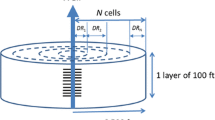Abstract
The process of water influx can provide natural driving energy in the development of gas-condensate reservoirs, whereas it may also cause the abandonment of production wells by water breakthrough. Under specific reservoir conditions, water influx is controlled by the size and shape of the aquifer, aquifer permeability and viscosity, as well as gas production rate. Therefore, it is critical to clarify the correlation between different patterns of water influx and recovery efficiency. This research takes a deepwater turbidite sandstone reservoir as the object, the aquifer volume, and gas production rate are changed through numerical simulation to analyze the effect of water influx on recovery efficiency. It suggests that the medium to large aquifers result in higher reservoir abandonment pressures by early water breakthrough, and lower gas recovery efficiencies. The gas and condensate recoveries of the weak aquifer case are slightly higher than the depletion case since it provides additional influx energy to the depletion reservoir. Moreover, the condensate-gas ratio of the higher abandonment pressure cases is much higher than depletion cases, which greatly improves condensate recovery. Gas recovery efficiencies of medium and strong aquifers are greatly improved by higher gas rates since the fast gas rate can outrun the water influx movement, however, the depletion and weak aquifer cases, have almost no impact. On the contrary, the higher gas rate results in lower condensate recovery efficiency for all aquifer cases. It may be contributed to higher gas rate will yield (1) lower condensate gas ratio due to lower abandonment pressure and (2) larger pressure drawdown from the wellbore, which will trap more condensate dropout in the reservoir. These conclusions show an important guiding significance for the in-depth understanding of the driving effect in gas-condensate reservoirs and optimizing gas production rate to enhance recovery efficiency.
Access this chapter
Tax calculation will be finalised at checkout
Purchases are for personal use only
Similar content being viewed by others
References
Yang, S.L., Wei, J. Z.: Reservoir Physics, 1st edn. Petroleum Industry Press, Bei**g (2004)
Coats, K.H.: Simulation of gas condensate reservoir performance. J. Pet. Technol. 37, 1870–1886 (1985)
Raghavan, R., Jones, J.R.: Depletion performance of gas-condensate reservoirs. J. Pet. Technol 48, 725–731 (1996)
Guo, P., Wang, Z.H., Zhu, Z.Q., et al.: Technology for Enhancing Gas-Condensate Reservoir Recovery Efficiency and Case Studies. 1st edn. Petroleum Industry Press, Bei**g (2015)
Shi-lun, L., Yi, P., Lei, S.: A new idea on enhancing the recovery rate of condensate gas reservoirs. Nat. Gas Ind. 28 (9), 1–5 (2008)
Tong-wen, J., Zhu, Z.Q., **ong, Y., et al.: Dynamic Analysis Method and Practice of Circulating Gas Injection Development for Condensate Gas Reservoir. 1st edn. Petroleum Industry Press, Bei**g (2013)
Guo, P., **g, S.S., Peng, C.Z.: Technology and countermeasures for gas recovery enhancement. Nat. Gas Ind. 34(2), 48–55 (2014)
Song, D.S.: Research on Dynamic Characteristics and Analysis Method of Water-Drive Gas Reservoirs. Southwest Petroleum University, Sichuan (2012)
Izuwa, N.C., Nwosu, C.N.: Influence of aquifer support on gas condensate reservoir performance. In: Paper presented at the SPE Nigeria Annual International Conference and Exhibition, Lagos, Nigeria, August 2014 (2014)
Cui, C.Z., Wu, Z.X., Yang, Y., et al.: Prediction of water breakthrough time of vertical wells for bottom water condensate gas reservoirs considering dynamic gas-water interface. Fault-block Oil Gas Field 26(1), 58–61 (2019)
Tran, T.V., Truong, T.A., Ngo, A.T., Hoang, S.K., Trinh, V.X.: A case study of gas-condensate reservoir performance under bottom water drive mechanism. J. Petrol. Explor. Product. Technol. 9(1), 525–541 (2018). https://doi.org/10.1007/s13202-018-0487-7
Wang, B., Teasdale, T.S.: GASWAT-PC: a microcomputer program for gas material balance with water influx. In: Petroleum Industry Applications of Microcomputers, pp. 25–42. Society of Petroleum Engineers, Texas (1987)
Liang, B., et al.: In: IFEDC, pp 1-8. China Academic Journal Electronic Publishing House, Bei**g (2020)
Zhang, L.H., Guo, J.J.: Basic Principles of Reservoir Numerical Simulation. 2nd edn. Petroleum Industry Press, Bei**g (2014)
Fevang, Ø., Singh, K., Whitson, C.H.: Guidelines for choosing compositional and black-oil models for volatile oil and gas-condensate reservoirs. In: Paper presented at the SPE Annual Technical Conference and Exhibition, Dallas, Texas (2000)
Xu, F.Z: Research on dissection of gas reservoirs in Longfengshan gas field and development optimization. Chem. Enterp. Manag. 3, 209–211 (2019)
Kalaydjian, F.J-M., Bourbiaux, B.J., Lombard, J-M.: Predicting gas-condensate reservoir performance: how flow parameters are altered when approaching production wells. In: Paper Presented at the SPE Annual Technical Conference and Exhibition, Denver, Colorado (1996)
Barnum, R.S., Brinkman, F.P., Richardson, T.W., Spillette A.G.: Gas condensate reservoir behaviour: productivity and recovery reduction due to condensation. In: Paper presented at the SPE Annual Technical Conference and Exhibition, Dallas, Texas, October 1995 (1995)
Luo, M., Yang, J.F., Fu, Q.F., et al.: Sensitivity analysis research and application of condensate gas reservoir development plan. Contemp. Chem. Ind. 43(8), 58−62 (2014)
Fawzy, F.: Investigation of the optimum production strategies for the economic recovery of gas condensate reservoirs with different aquifer strength. In: Paper presented at the SPE Annual Technical Conference and Exhibition, San Antonio, Texas, USA (2017)
Acknowledgments
The project is supported by Reserves & Economic Evaluation Unit of SIPC Technical Support Center. The paper is elected by IPPTC Organizing Committee to presented at the International Petroleum and Petrochemical Technology Conference 2022 held online between 12–13 October 2022.
Author information
Authors and Affiliations
Corresponding authors
Editor information
Editors and Affiliations
Rights and permissions
Copyright information
© 2023 The Author(s), under exclusive license to Springer Nature Singapore Pte Ltd.
About this paper
Cite this paper
Wu, Yf., Na, Wh., Wang, B., Li, Y., Zhong, Xx., Ma, L. (2023). Influence of Aquifer Size and Gas Production Rate on Gas-Condensate Reservoir Performance. In: Lin, J. (eds) Proceedings of the 2022 International Petroleum and Petrochemical Technology Conference. IPPTC 2022. Springer, Singapore. https://doi.org/10.1007/978-981-99-2649-7_4
Download citation
DOI: https://doi.org/10.1007/978-981-99-2649-7_4
Published:
Publisher Name: Springer, Singapore
Print ISBN: 978-981-99-2648-0
Online ISBN: 978-981-99-2649-7
eBook Packages: EnergyEnergy (R0)




